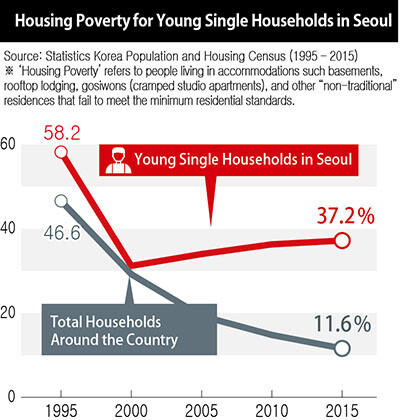hankyoreh
Links to other country sites 다른 나라 사이트 링크
“Housing Poverty” on the rise for young singles in Seoul

Around four in ten young Seoulites living on their own occupy housing that fails to meet minimum residential standards, a study shows. While the overall housing poverty rate is in decline, the situation has become steadily worse since 2000 for young single-person households.
On Oct. 9, the Hankyoreh and the Hankyoreh Economy & Society Research Institute obtained figures from the Statistics Korea Statistical Research Institute through the office of Democratic Party lawmaker and National Assembly Strategy and Finance Committee member Park Kwang-on. The analysis, which focused on 2015 census data on young households living in basement or rooftop residences and residences failing to meet minimum housing standards, showed a total of 290,000 households headed by a person aged 20–34 falling below minimum housing standards, or 11.3% of all households nationwide. The number of young “housing poor” households, which included these as well as basement and rooftop accommodations and “other non-residential dwellings,” amounted to 450,000, or 17.6%.
The housing poverty situation was more serious in Seoul than in the rest of South Korea, particularly with single-person households. For young households, the housing poverty rate in Seoul stood at 29.6%, much higher than the 17.6% rate nationwide; for young single-person households, the respective rates were 37.2% and 22.6%.
Whereas the overall housing poverty rate has fallen over time, the rate for young single-person households in Seoul has been on the rise since 2000. Between 1995 and 2015, the overall housing poverty rate fell from 46.6% to 11.6% – but for young single-person households in Seoul, it has steadily increased to 37.2% as of 2015 after previously dipping from 58.2% in 1995 to 31.2% in 2000.
Among Seoul’s districts, the rate was highest in Gwanak at 42.7%, followed by Dongjak at 30%, Seongbuk at 29.3%, and Dongdaemun at 25.8%. The rates were particularly high in Gwanak and Dongjak, which are home to large numbers of tiny one-room “gosiwons” in the Sillim and Noryangjin neighborhoods. Among young single-person households in Seoul, the number of households occupying gosiwons and other “non-housing dwellings” has risen steadily from 2,818 in 2005 to 22,644 in 2010 and 38,906 in 2015.
“The housing poverty rate for young single-person households in Seoul has differed from the overall trend for South Korea, where a large supply of apartments has led to a reduction in the housing poverty rate,” said Korea Center for City and Environment Research senior fellow Choi Eun-young.
“This kind of reversal was never seen at all with other generations,” Choi commented.
Im Gyeong-ji, head of the non-profit organization Mindalpaengi Union, explained, “In addition to the high rate of occupancy in gosiwons and other non-residential dwellings for young single-person households lacking the resources to pay a security deposit, these households are also vulnerable to housing poverty while occupying illegal structures built around universities.”
“There needs to be oversight and monitoring of illegal structures and failure to meet minimal housing standards,” Im said.
By Park Ki-yong, staff reporter
Please direct questions or comments to [english@hani.co.kr]

Editorial・opinion
![[Editorial] Does Yoon think the Korean public is wrong? [Editorial] Does Yoon think the Korean public is wrong?](https://flexible.img.hani.co.kr/flexible/normal/500/300/imgdb/original/2024/0417/8517133419684774.jpg) [Editorial] Does Yoon think the Korean public is wrong?
[Editorial] Does Yoon think the Korean public is wrong?![[Editorial] As it bolsters its alliance with US, Japan must be accountable for past [Editorial] As it bolsters its alliance with US, Japan must be accountable for past](https://flexible.img.hani.co.kr/flexible/normal/500/300/imgdb/original/2024/0417/6817133413968321.jpg) [Editorial] As it bolsters its alliance with US, Japan must be accountable for past
[Editorial] As it bolsters its alliance with US, Japan must be accountable for past- [Guest essay] Amending the Constitution is Yoon’s key to leaving office in public’s good graces
- [Editorial] 10 years on, lessons of Sewol tragedy must never be forgotten
- [Column] A death blow to Korea’s prosecutor politics
- [Correspondent’s column] The US and the end of Japanese pacifism
- [Guest essay] How Korea turned its trainee doctors into monsters
- [Guest essay] As someone who helped forge Seoul-Moscow ties, their status today troubles me
- [Editorial] Koreans sent a loud and clear message to Yoon
- [Column] In Korea’s midterm elections, it’s time for accountability
Most viewed articles
- 1[Column] The clock is ticking for Korea’s first lady
- 2Samsung barricades office as unionized workers strike for better conditions
- 3[Editorial] When the choice is kids or career, Korea will never overcome birth rate woes
- 4[Guest essay] How Korea turned its trainee doctors into monsters
- 5Why Israel isn’t hitting Iran with immediate retaliation
- 6S. Korea, Japan reaffirm commitment to strengthening trilateral ties with US
- 7Japan officially says compensation of Korean forced laborers isn’t its responsibility
- 8[Editorial] As it bolsters its alliance with US, Japan must be accountable for past
- 9Korea, Japan jointly vow response to FX volatility as currencies tumble
- 10‘Right direction’: After judgment day from voters, Yoon shrugs off calls for change